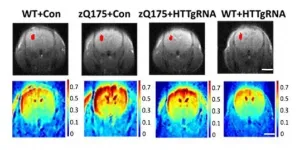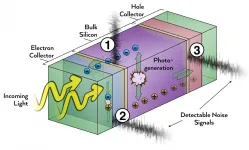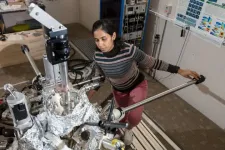(Press-News.org) A decade's worth of data shows that neonatologists are shifting the type of respiratory support they utilize for preterm infants, a move that could lead to improved health outcomes.
Using two large national datasets that included more than 1 million preterm infants, researchers in a new Vanderbilt-led study found that from 2008 to 2018 there was a greater than 10% decrease in the use of mechanical ventilation for this patient population. Concurrently, there was a similar increase in the use of non-invasive respiratory support, such as continuous positive airway pressure (CPAP), for these infants.
The study, "Changes in Use of Respiratory Support for Preterm Infants in the U.S.," published July 6 in JAMA Pediatrics.
"It's a pretty big success story for the field of neonatology. We've been able to keep a lot of babies off mechanical ventilation and potentially spare them of lung injury and injuries to other organ systems as well," said Dupree Hatch, MD, MPH, senior study author and assistant professor of Pediatrics in the Division of Neonatology at Monroe Carell Jr. Children's Hospital at Vanderbilt.
For preterm infants, mechanical ventilation can have adverse pulmonary and neurodevelopmental outcomes. To reduce these risks, neonatologists over the past two decades have been exploring and researching non-invasive respiratory support options like CPAP therapy for these infants. Much of the shift in mechanical ventilation seen in the study coincided with a large study released in 2010 that showed mechanical ventilation was not superior to non-invasive ventilation, and in fact may involve more risks.
"In multiple studies mechanical ventilation has been associated with adverse outcomes. There are several studies that show for every week you stay on a ventilator as a preterm baby, your odds of having adverse neurodevelopmental outcomes go up," Hatch said.
"Since large studies were published in 2008, 2010 and 2011 showing the effectiveness of non-invasive respiratory support, we thought that respiratory support patterns in preterm infants had likely changed, but no one had really quantified that, or looked if it was widespread across the entire country or if it was just in pockets."
Hatch and colleagues examined two large national datasets, confirming the changes in practices. They looked at data collected over an 11-year period on the type of respiratory support used for infants born between 22 weeks' and 34 weeks' gestation.
In one of the study datasets that included admissions to over 350 NICUs in the U.S., they found that mechanical ventilation utilization in preterm infants decreased from 29.4% in 2008 to 18.5% in 2018. Nationally, the study authors wrote, the changes were associated with about 30,000 fewer infants receiving mechanical ventilation during the study period. As the number of infants on mechanical ventilation went down, the duration of time that ventilated babies spent on mechanical ventilators also went down.
Also, in their findings, researchers discovered that the total number of days on non-invasive respiratory support went up across all gestational ages from 13.8 days to 15.4 days. Hatch said more research is needed to understand the implications of spending more time on non-invasive respiratory support therapies.
"We need to figure out if the increase in duration of respiratory support is a good thing, and what does that do to NICU length of stay and overall resource utilization for preterm infants in the U.S. It raises more questions," he said.
Additionally, they saw an increase in the number of extremely preterm infants, 22 to 24 weeks' gestation, being placed on mechanical ventilation as there has been increased intervention and improved survival for this age group. Hatch notes that the respiratory support strategies for this particular population of infants needs more examination.
"The field of neonatology has worked really hard to examine our practices and get better. I am proud of how quickly some of the landmark respiratory care studies have penetrated our clinical care," said Hatch. "Care in the NICU is becoming less invasive and gentler because it is the right thing to do for babies' long-term outcomes."
INFORMATION:
Other Vanderbilt researchers involved in the study include Stephen Patrick, MD, MPH, MS, and Wes Ely, MD, MPH. Authors used the National Inpatient Sample and the Pediatrix BabySteps Clinical Data Warehouse for study data.
(Boston)--The discovery of novel groups or categories within diseases, organisms and biological processes and their organization into hierarchical relationships are important and recurrent pursuits in biology and medicine, which may help elucidate group-specific vulnerabilities and ultimately novel therapeutic interventions.
Now a new study introduces a novel computational methodology and an associated software tool called K2Taxonomer, which support the automated discovery and annotation of molecular classifications at multiple levels of resolution from high-throughput bulk and single cell 'omics' data. The study includes a case ...
SILVER SPRING, Md.--Vaccines such as Pfizer, Moderna, Johnson & Johnson and AstraZeneca are designed to prevent severe Coronavirus-19 Disease (COVID-19) due to acute respiratory syndrome coronavirus 2 (SARS-CoV-2) and are highly efficacious. The efficacy is not different in people with and without obesity except for AstraZeneca which is not known, according to a new position statement from The Obesity Society (TOS), the leading scientific membership organization advancing the science-based understanding of the causes, consequences, prevention and treatment of obesity.
Trials have demonstrated high efficacy in individuals ...
In a new study on mice, Johns Hopkins Medicine researchers report that using MRI scans to measure blood volume in the brain can serve as a noninvasive way to potentially track the progress of gene editing therapies for early-stage Huntington's disease, a neurodegenerative disorder that attacks brain cells. The researchers say that by identifying and treating the mutation known to cause Huntington's disease with this type of gene therapy, before a patient starts showing symptoms, it may slow progression of the disease.
The findings of the study were published May 27 in the journal Brain.
"What's exciting about this study is the opportunity to identify a reliable biomarker that can ...
Hamilton, ON (July 7, 2021) - A McMaster University team of researchers recently discovered how, exactly, the COVID-19 vaccines that use adenovirus vectors trigger a rare but sometimes fatal blood clotting reaction called vaccine-induced immune thrombotic thrombocytopenia or VITT.
The findings will put scientists on the path of finding a way to better diagnose and treat VITT, possibly prevent it and potentially make vaccines safer.
The researchers' article was fast-tracked for publication today by the prestigious journal Nature in its accelerated article preview because of the importance of the research.
"Our work also answers important ...
A genetic map of an aggressive childhood brain tumour called medulloblastoma has helped researchers identify a new generation anti-cancer drug that can be repurposed as an effective treatment for the disease.
This international collaboration, led by researchers from The University of Queensland's (UQ) Diamantina Institute and WEHI in Melbourne, could give parents hope in the fight against the most common and fatal brain cancer in children.
UQ lead researcher Dr Laura Genovesi said the team had mapped the genetics of these aggressive brain tumours for five ...
Some exceptionally gifted people have marked human history and culture. Leonardo, Mozart, and Einstein are some famous examples of this phenomenon.
Is talent in a given field a uniquely human phenomenon? We do not know whether gifted bees or elephants exist, just to name a few species, but now there is evidence that talent in a specific field exists, in at least one non-human species: the dog.
A new study, just published in Scientific Reports, found that, while the vast majority of dogs struggle to learn object labels (such as the names of their toys), when tested in strictly controlled conditions, a handful of gifted word learner ...
As society moves towards a renewable energy future, it's crucial that solar panels convert light into electricity as efficiently as possible. Some state-of-the-art solar cells are close to the theoretical maximum of efficiency--and physicists from the University of Utah and Helmholtz-Zentrum Berlin have figured out a way to make them even better.
In a new study, physicists used a technique known as cross-correlation noise spectroscopy to measure miniscule fluctuations in electrical current flowing between materials inside silicon solar cells. The researchers identified crucial electrical ...
Nature has a vast store of medicinal substances. "Over 50 percent of all drugs today are inspired by nature," says Gisbert Schneider, Professor of Computer-Assisted Drug Design at ETH Zurich. Nevertheless, he is convinced that we have tapped only a fraction of the potential of natural products. Together with his team, he has successfully demonstrated how artificial intelligence (AI) methods can be used in a targeted manner to find new pharmaceutical applications for natural products. Furthermore, AI methods are capable of helping to find alternatives to these compounds that have the same effect but are much easier and therefore cheaper to ...
Researchers at the IBS Center for Quantum Nanoscience at Ewha Womans University (QNS) have shown that dysprosium atoms resting on a thin insulating layer of magnesium oxide have magnetic stability over days. In a study published in Nature Communications they have proven that these tiny magnets have extreme robustness against fluctuations in magnetic field and temperature and will flip only when they are bombarded with high energy electrons through the STM-tip.
Using these ultra-stable and yet switchable single-atom magnets, the team has shown atomic-scale control of the magnetic field within ...
Dr Bock, under the mentorship of Distinguished Professor Dietmar Hutmacher, from QUT Centre for Biomedical Technologies, has focused her research on bone metastases from breast and prostate cancers.
She developed 3D miniature bone-like tissue models in which 3D printed biomimetic scaffolds are seeded with patient-derived bone cells and tumour cells to be used as clinical and preclinical drug testing tools.
The research team investigated their hypothesis that traditional anti-androgen therapy had limited effect in the microenvironment of prostate cancer bone tumours. The team's findings are published in Science Advances.
"We wanted to see if the therapy could be a contributor of cancer cells' adaptive responses that fuelled bone ...






